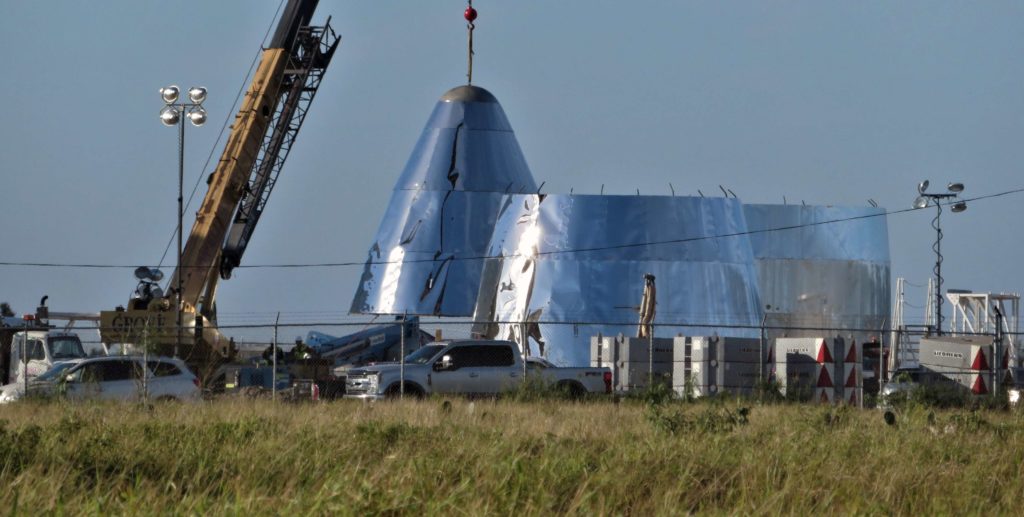

SpaceX
SpaceX CEO Elon Musk: Starship prototype to have 3 Raptors and “mirror finish”
Taking to Twitter once more to reveal additional information about SpaceX’s radically changing BFR/Starship prototype program, CEO Elon Musk has made an unexpected visit to the company’s South Texas BFR testing facilities to oversee rapid progress with a low-fidelity hop test prototype of the orbital Starship spacecraft.
Included in a handful of replies that followed the tweeted image, Musk described some of the key advantages of a stainless steel Starship – including mirror-like thermal reflectivity for hot reentries and a “usable” strength-to-mass ratio superior to carbon fiber – as well as features of prototype cousin.
Stainless Steel Starship pic.twitter.com/rRoiEKKrYc
— Elon Musk (@elonmusk) December 24, 2018
While the CEO did imply on Saturday that the Mars-focused Raptor engine had been what he described as “radically redesigned”, Musk’s statement that the Starship hopper will feature three Raptor engines does at least set a lower bound for the ship’s maximum gross takeoff weight when the time comes for it to take flight.
Yes. Radically redesigned Raptor ready to fire next month.
— Elon Musk (@elonmusk) December 22, 2018
While the suggestion that Raptor’s turbopumps (basically fuel pumps) would need at least 100,000 HP per engine seems to indicate that the flight design’s thrust has been appreciably uprated, a past figure of ~2000 kN (450,000 lbf) per engine suggests that Starship V0.1 could weigh as much as an entire Falcon 9 Block 5 rocket (~1.2 million pounds, 550,000 kg) and still having a solid 80-100% of Falcon 9’s liftoff thrust. Put simply, the rocket that appears to be coming together in the boonies of South Texas could rival almost any other liquid fuel rocket booster in service, while still being the testbed for BFR’s upper stage alone.
While it’s ambiguous if several additional comments applied to the Starship prototype, the final product, or both, Musk also indicated that some of the biggest benefits of a shift away from carbon composites to stainless steel would be relative ease with which the material handles extreme heating. Thanks to the fact that stainless steel can ultimately be polished to mirror-like levels of reflectivity and that mirrors are some of the most efficient reflectors of thermal energy (heat), shiny and unpainted steel would ultimately perform far better than carbon composites and could end up requiring “much less” heat shielding for the same performance.
- ¯\_(ツ)_/¯ (bocachicagal – NASASpaceflight)
- A conspicuous nosecone appears to have arisen inside SpaceX’s new Boca Chica tent, adjacent to what looks like a water tower with tube legs. (bocachicagal – NASASpaceflight)
- Boca Chica, 12/23/18. (NASASpaceflight /u/bocachicagal)
- It remains to be seen if BFR can be made as reusable and reliable as it will need to be to sustainably support interplanetary humans. (SpaceX)
- Starship – in its 2018 design iteration – seen landing on Mars atop pillars of Raptor flame. (SpaceX)
Perhaps most unintuitive is the fact that steel can apparently beat carbon composites when it comes to usable strength-to-weight ratios at supercool temperatures. According to Musk, steel also performs “vastly better” at high temperatures and appreciably better at room temperatures. A comment made on Saturday may lend additional credence to what seems at face value to contradict basic material intuition – at least some of the stainless steel SpaceX is examing would be a special (presumably SpaceX-engineered) alloy that has undergone what is known as cryogenic treatment, in which metals are subjected to extremely cold conditions to create some seriously unintuitive properties. Ultimately, cold-formed/worked or cryo-treated steel can be dramatically lighter and more wear-resistant than traditional hot-rolled steel.
Usable strength/weight of full hard stainless at cryo is slightly better than carbon fiber, room temp is worse, high temp is vastly better
— Elon Musk (@elonmusk) December 24, 2018
Combined with advanced new alloys and a uniquely strong handle on working with supercool propellant (likely transferable to cold-forming steel), SpaceX and CEO Elon Musk could have a true breakthrough on their hands, especially if it turns out that a great deal of deep thought, analysis, and refinement fed into these “radical” design changes. With Starship Alpha’s hop tests potentially beginning as early as March 2019, we won’t have long to wait to find out.
For prompt updates, on-the-ground perspectives, and unique glimpses of SpaceX’s rocket recovery fleet check out our brand new LaunchPad and LandingZone newsletters!
News
SpaceX launches Ax-4 mission to the ISS with international crew
The SpaceX Falcon 9 launched Axiom’s Ax-4 mission to ISS. Ax-4 crew will conduct 60+ science experiments during a 14-day stay on the ISS.

SpaceX launched the Falcon 9 rocket kickstarting Axiom Space’s Ax-4 mission to the International Space Station (ISS). Axiom’s Ax-4 mission is led by a historic international crew and lifted off from Kennedy Space Center’s Launch Complex 39A at 2:31 a.m. ET on June 25, 2025.
The Ax-4 crew is set to dock with the ISS around 7 a.m. ET on Thursday, June 26, 2025. Axiom Space, a Houston-based commercial space company, coordinated the mission with SpaceX for transportation and NASA for ISS access, with support from the European Space Agency and the astronauts’ governments.
The Ax-4 mission marks a milestone in global space collaboration. The Ax-4 crew, commanded by U.S. astronaut Peggy Whitson, includes Shubhanshu Shukla from India as the pilot, alongside mission specialists Sławosz Uznański-Wiśniewski from Poland and Tibor Kapu from Hungary.
“The trip marks the return to human spaceflight for those countries — their first government-sponsored flights in more than 40 years,” Axiom noted.
Shukla’s participation aligns with India’s Gaganyaan program planned for 2027. He is the first Indian astronaut to visit the ISS since Rakesh Sharma in 1984.
Axiom’s Ax-4 mission marks SpaceX’s 18th human spaceflight. The mission employs a Crew Dragon capsule atop a Falcon 9 rocket, designed with a launch escape system and “two-fault tolerant” for enhanced safety. The Axiom mission faced a few delays due to weather, a Falcon 9 leak, and an ISS Zvezda module leak investigation by NASA and Roscosmos before the recent successful launch.
As the crew prepares to execute its scientific objectives, SpaceX’s Ax-4 mission paves the way for a new era of inclusive space research, inspiring future generations and solidifying collaborative ties in the cosmos. During the Ax-4 crew’s 14-day stay in the ISS, the astronauts will conduct nearly 60 experiments.
“We’ll be conducting research that spans biology, material, and physical sciences as well as technology demonstrations,” said Whitson. “We’ll also be engaging with students around the world, sharing our experience and inspiring the next generation of explorers.”
SpaceX’s Ax-4 mission highlights Axiom’s role in advancing commercial spaceflight and fostering international partnerships. The mission strengthens global space exploration efforts by enabling historic spaceflight returns for India, Poland, and Hungary.
News
Starlink Cellular’s T-Mobile service to grow with third-party app data
From Oct 2025, T-Satellite will enable third-party apps in dead zones! WhatsApp, X, AccuWeather + more coming soon.

Starlink Cellular’s T-Mobile service will expand with third-party app data support starting in October, enhancing connectivity in cellular dead zones.
T-Mobile’s T-Satellite, supported by Starlink, launches officially on July 23. Following its launch, T-Mobile’s Starlink Cellular service will enable data access for third-party apps like WhatsApp, X, Google, Apple, AccuWeather, and AllTrails on October 1, 2025.
T-Mobile’s Starlink Cellular is currently in free beta. T-Satellite will add MMS support for Android phones on July 23, with iPhone support to follow. MMS support allows users to send images and audio clips alongside texts. By October, T-Mobile will extend emergency texting to all mobile users with compatible phones, beyond just T-Mobile customers, building on its existing 911 texting capability. The carrier also provides developer tools to help app makers integrate their software with T-Satellite’s data service, with plans to grow the supported app list.
T-Mobile announced these updates during an event celebrating an Ookla award naming it the best U.S. phone network, a remarkable turnaround from its last-place ranking a decade ago.
“We not only dream about going from worst to best, we actually do it. We’re a good two years ahead of Verizon and AT&T, and I believe that lead is going to grow,” said T-Mobile’s Chief Operating Officer Srini Gopalan.
T-Mobile unveiled two promotions for its Starlink Cellular services to attract new subscribers. A free DoorDash DashPass membership, valued at $10/month, will be included with popular plans like Experience Beyond and Experience More, offering reduced delivery and service fees. Meanwhile, the Easy Upgrade promotion targets Verizon customers by paying off their phone balances and providing flagship devices like the iPhone 16, Galaxy S25, or Pixel 9.
T-Mobile’s collaboration with SpaceX’s Starlink Cellular leverages orbiting satellites to deliver connectivity where traditional networks fail, particularly in remote areas. Supporting third-party apps underscores T-Mobile’s commitment to enhancing user experiences through innovative partnerships. As T-Satellite’s capabilities grow, including broader app integration and emergency access, T-Mobile is poised to strengthen its lead in the U.S. wireless market.
By combining Starlink’s satellite technology with strategic promotions, T-Mobile is redefining mobile connectivity. The upcoming third-party app data support and official T-Satellite launch mark a significant step toward seamless communication, positioning T-Mobile as a trailblazer in next-generation wireless services.
News
Starlink expansion into Vietnam targets the healthcare sector
Starlink aims to deliver reliable internet to Vietnam’s remote clinics, enabling telehealth and data sharing.

SpaceX’s Starlink expansion into Vietnam targets its healthcare sector. Through Starlink, SpaceX seeks to drive digital transformation in Vietnam.
On June 18, a SpaceX delegation met with Vietnam’s Ministry of Health (MoH) in Hanoi. SpaceX’s delegation was led by Andrew Matlock, Director of Enterprise Sales, and the discussions focused on enhancing connectivity for hospitals and clinics in Vietnam’s remote areas.
Deputy Minister of Health (MoH) Tran Van Thuan emphasized collaboration between SpaceX and Vietnam. Tran stated: “SpaceX should cooperate with the MoH to ensure all hospitals and clinics in remote areas are connected to the StarLink satellite system and share information, plans, and the issues discussed by members of the MoH. The ministry is also ready to provide information and send staff to work with the corporation.”
The MoH assigned its Department of Science, Technology, and Training to work with SpaceX. Starlink Vietnam will also receive support from Vietnam’s Department of International Cooperation. Starlink Vietnam’s agenda includes improving internet connectivity for remote healthcare facilities, developing digital infrastructure for health examinations and remote consultations, and enhancing operational systems.
Vietnam’s health sector is prioritizing IT and digital transformation, focusing on electronic health records, data centers, and remote medical services. However, challenges persist in deploying IT solutions in remote regions, prompting Vietnam to seek partnerships like SpaceX’s.
SpaceX’s Starlink has a proven track record in healthcare. In Rwanda, its services supported 40 health centers, earning praise for improving operations. Similarly, Starlink enabled remote consultations at the UAE’s Emirati field hospital in Gaza, streamlining communication for complex medical cases. These successes highlight Starlink’s potential to transform Vietnam’s healthcare landscape.
On May 20, SpaceX met with Vietnam’s Ministry of Industry and Trade, announcing a $1.5 billion investment to provide broadband internet, particularly in remote, border, and island areas. The first phase includes building 10-15 ground stations across the country. This infrastructure will support Starlink’s healthcare initiatives by ensuring reliable connectivity.
Starlink’s expansion in Vietnam aligns with the country’s push for digital transformation, as outlined by the MoH. By leveraging its satellite internet expertise, SpaceX aims to bridge connectivity gaps, enabling advanced healthcare services in underserved regions. This collaboration could redefine Vietnam’s healthcare infrastructure, positioning Starlink as a key player in the nation’s digital future.
-

 Elon Musk2 weeks ago
Elon Musk2 weeks agoTesla investors will be shocked by Jim Cramer’s latest assessment
-

 Elon Musk2 days ago
Elon Musk2 days agoxAI launches Grok 4 with new $300/month SuperGrok Heavy subscription
-

 Elon Musk5 days ago
Elon Musk5 days agoElon Musk confirms Grok 4 launch on July 9 with livestream event
-

 News1 week ago
News1 week agoTesla Model 3 ranks as the safest new car in Europe for 2025, per Euro NCAP tests
-

 Elon Musk2 weeks ago
Elon Musk2 weeks agoA Tesla just delivered itself to a customer autonomously, Elon Musk confirms
-

 Elon Musk1 week ago
Elon Musk1 week agoxAI’s Memphis data center receives air permit despite community criticism
-

 News2 weeks ago
News2 weeks agoXiaomi CEO congratulates Tesla on first FSD delivery: “We have to continue learning!”
-

 News2 weeks ago
News2 weeks agoTesla sees explosive sales growth in UK, Spain, and Netherlands in June
























